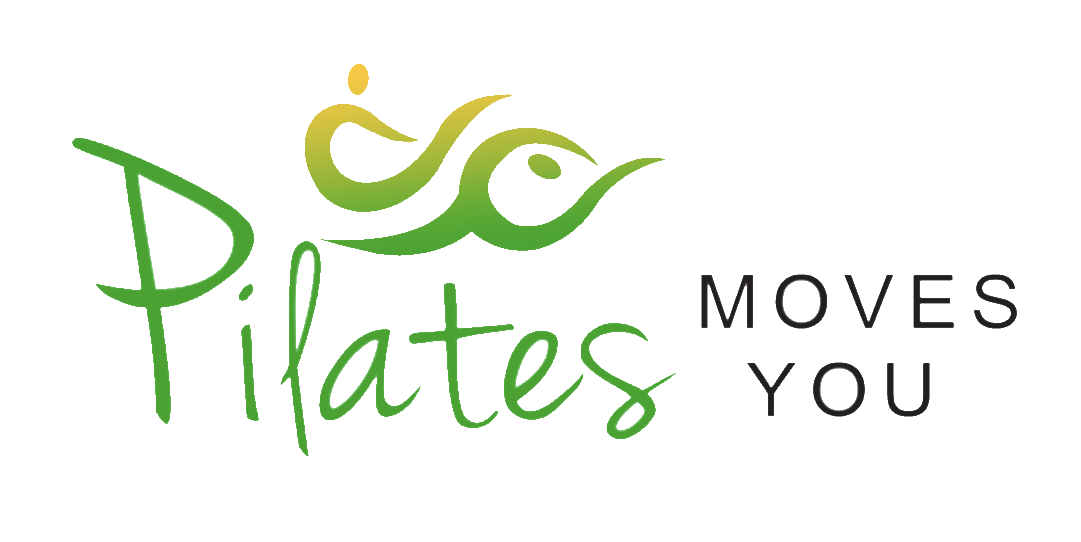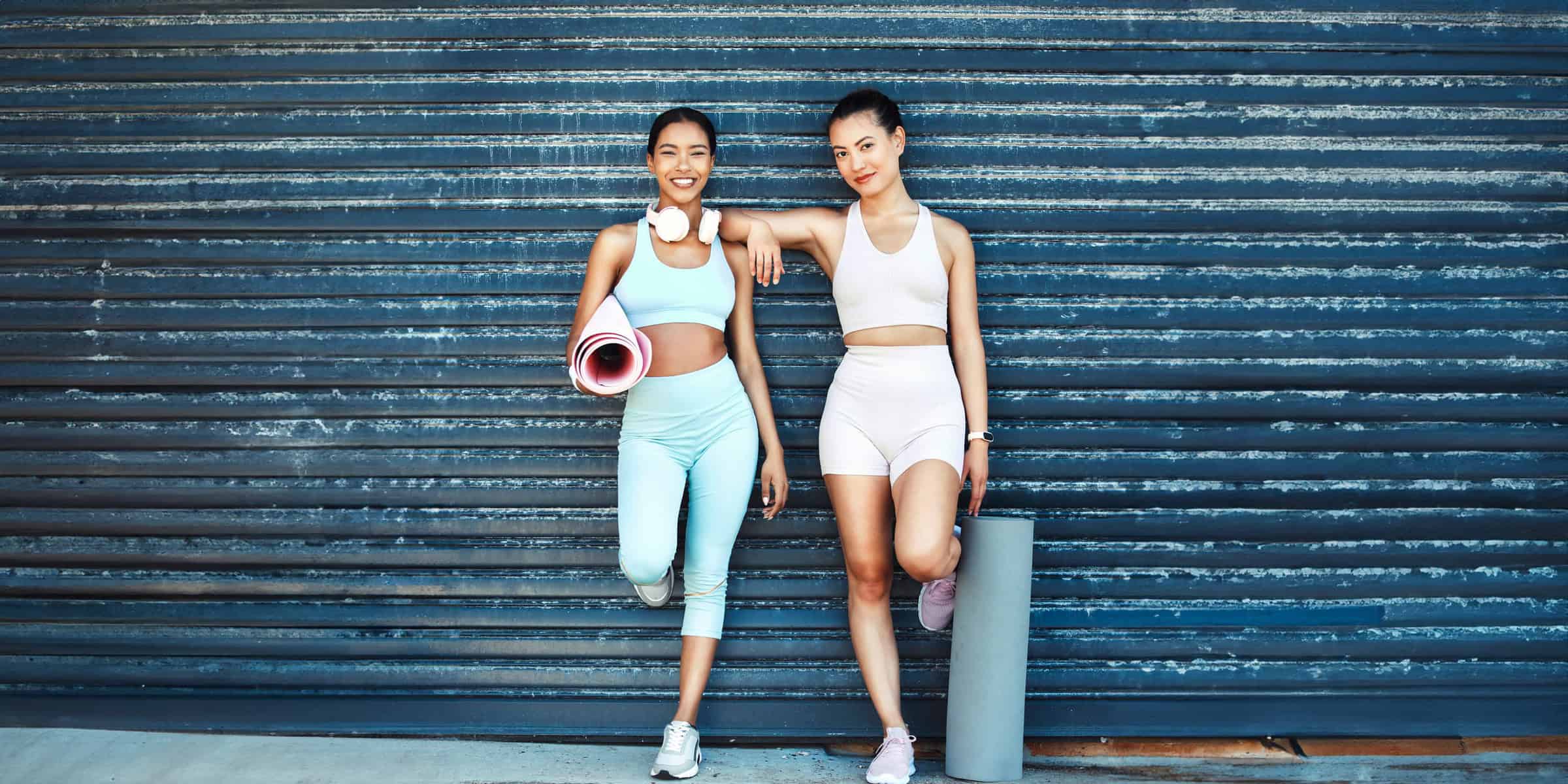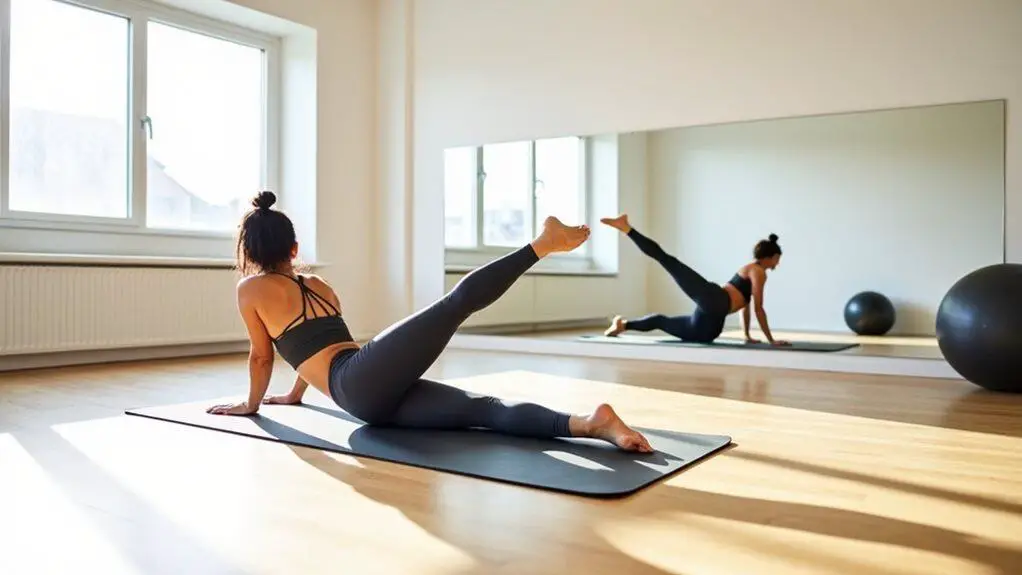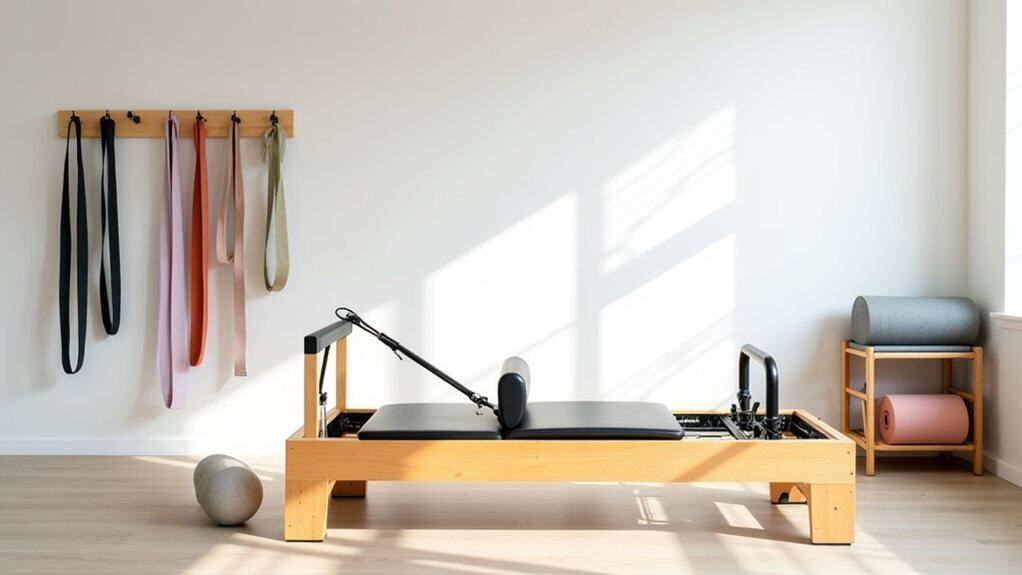Have you ever wondered how effective wall Pilates is in improving overall strength and flexibility? With a recent explosion in interest, many questions whether it can be a beneficial form of exercise, but does it really live up to the hype?
Wall Pilates is a highly effective form of Pilates that utilizes the wall as a prop for support and resistance. It can help improve posture, core strength, flexibility, and overall body awareness. The wall provides stability and allows for proper alignment, making exercises more accessible and effective. Wall Pilates is suitable for all fitness levels and can be a great addition to any Pilates practice.
It doesn’t matter your fitness level of Pilates experience, the wall can add a new dimension to your routine.
What is wall Pilates?
Wall Pilates is exactly what it sounds like, a form of exercise that combines traditional Pilates movements with the support of a wall.
It is designed to target and strengthen the core muscles while providing extra resistance and stability. This low-impact workout is accessible for all fitness levels and can be performed at home or in a gym setting.
Wall Pilates offers a unique and effective approach to the mind-body connection that Joseph Pilates intended.
By using the wall as a prop, practitioners can work on improving their form, balance, and alignment, while challenging their muscles in new and innovative ways.
With exercises such as wall squats, glute bridges, and challenging positions, wall Pilates provides a killer core workout that not only tones the abdominal muscles but also strengthens the upper body, pelvic floor, and upper back. Whether you are a beginner or an experienced Pilates enthusiast, wall Pilates can add a new dimension to your fitness routine and help you take your strength journey to the next level.
The Rise of Wall Pilates
While Pilates has been popular for many years, Wall Pilates only gained traction relatively recently. Google have a brilliant tool called Google Trends that lets you see the popularity of search terms over time, and you can see the explosion in interest kicked in 2021/2022.
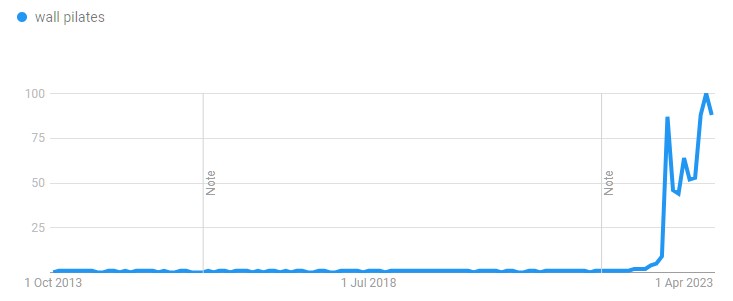
This interest has been fuelled by TikTok, with short examples of Wall Pilates raking up millions of views. These short form videos have lead people interested to try it out to search Google and YouTube for the full, long form, workout videos.
Which has been great for my channel!
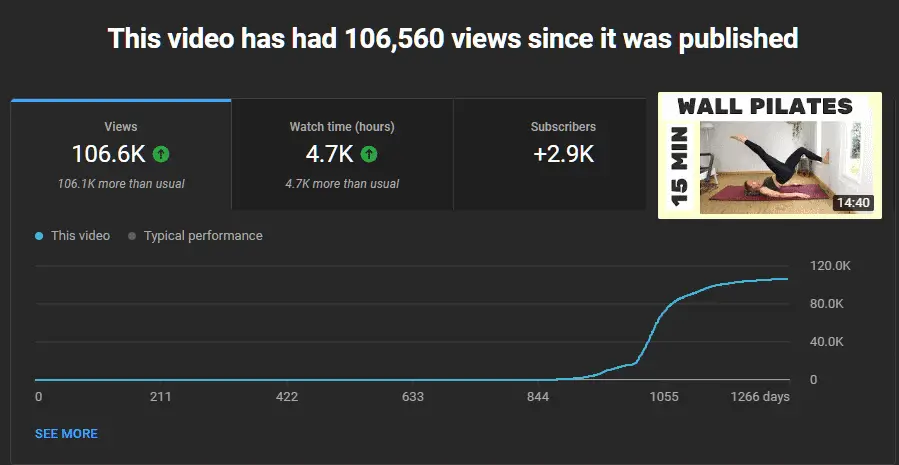
Benefits of Wall Pilates
Wall Pilates is an effective workout that offers numerous benefits to individuals of all fitness levels. One of the main advantages of this exercise is its ability to enhance core strength.
By utilizing the wall as a support, individuals can engage their deep abdominal muscles and strengthen their core effectively. This not only improves overall stability and balance but also enhances posture.
In addition to core strength, Wall Pilates offers various other benefits. It enhances flexibility by targeting and stretching different muscle groups.
This increased flexibility not only improves movement but also reduces the risk of injuries. Furthermore, this low-impact exercise reduces stress and promotes relaxation by emphasizing the mind-body connection.
Wall Pilates is also known for toning muscles and improving joint health. By incorporating exercises like glute bridges and wall squats, it helps to strengthen and tone the muscles in the legs, hips, and glutes. Moreover, the controlled movements and proper form practiced in Wall Pilates promote joint stability and improve joint health.
Whether you are an experienced athlete or just starting your fitness journey, Wall Pilates provides an accessible and effective workout routine.
By targeting key muscle groups and offering challenging exercises in the form of a low-impact exercise system, it is the perfect choice for individuals looking to strengthen their core, improve overall muscle tone, and enhance their overall fitness levels.
Core Strength and Body Weight
Core strength is a crucial component of overall fitness and plays a significant role in maintaining good posture, preventing injuries, and enhancing performance in various activities.
Wall Pilates, a form of exercise that utilizes body weight and a wall as a prop, is highly effective in targeting and strengthening the core muscles.
By engaging the abdominal muscles, obliques, and lower back, Wall Pilates helps to develop a strong core, which serves as a foundation for efficient movement and stability throughout the body.
This type of exercise enables individuals to work on their core strength without the need for expensive equipment or a gym membership, making it accessible to people of all fitness levels.
Whether you are a beginner or a seasoned fitness enthusiast, incorporating Wall Pilates into your workout routine can provide a challenging and effective workout that focuses on developing a strong core and improving overall body strength.
Core Muscles Strengthened During Wall Pilates
Wall Pilates is an effective workout that targets and strengthens the core muscles. These muscles play a crucial role in providing stability and support to the body.
During Wall Pilates, the core muscles, including the abdominal muscles, obliques, and the muscles of the lower back, are specifically targeted and engaged. These exercises effectively strengthen these muscles by using body weight and the resistance offered by the wall.
Exercises such as wall squats and glute bridges engage the thighs, glutes, and the core muscles. In wall squats, the core muscles are engaged to maintain balance and stability while the thighs are parallel to the ground. This exercise targets the quadriceps, hamstrings, and glutes, while simultaneously challenging the core muscles.
In glute bridges against the wall, the core muscles are strengthened to maintain proper form and stability as the hips are raised off the ground. This exercise primarily targets the glutes and hamstrings, while engaging the core muscles for stability and support.
By targeting and engaging the core muscles in Wall Pilates, individuals can improve their core strength, stability, and overall fitness levels. With the use of the wall as an extra resistance, these exercises offer a low-impact yet challenging workout that is accessible to people of all fitness levels.
In conclusion, Wall Pilates provides an effective workout for strengthening the core muscles. By targeting and engaging these muscles, individuals can enhance their core strength, stability, and overall fitness levels. Incorporating Wall Pilates into your fitness routine can offer a low-impact yet challenging exercise system that can benefit individuals at any level of strength or on their strength journey.
How Wall Pilates Supports the Body’s Weight
Wall Pilates is an effective form of exercise that offers additional stability for the spine, enabling individuals to properly engage their deep abdominal muscles. This support is crucial for improving core strength and posture, which is especially beneficial for people with sedentary lifestyles.
During Wall Pilates, the body’s weight is supported by the wall, allowing individuals to focus on activating and strengthening their core muscles without placing excessive strain on the spine. The wall provides a stable surface against which individuals can push, creating a supportive environment for the body to perform the exercises.
By engaging the deep abdominal muscles, which include the transverse abdominis and the obliques, Wall Pilates helps improve core strength. These key muscles play a vital role in stabilizing the spine and maintaining good posture. Regular practice of Wall Pilates can therefore help correct muscle imbalances and improve overall body alignment.
In addition to supporting the body’s weight and enhancing core strength, Wall Pilates also benefits joint health and motion. The use of the wall as a stability tool allows individuals to perform exercises with proper form, reducing the risk of joint injury. This low-impact workout targets the major muscle groups and enhances joint flexibility, promoting overall joint health.
In summary, Wall Pilates provides the necessary support for the body’s weight, allowing individuals to properly engage their deep abdominal muscles. This support is crucial for improving core strength and posture. Additionally, Wall Pilates supports overall joint health and motion, making it an effective form of exercise for individuals of all fitness levels.
Extra Resistance with Wall Pilates for Increased Fitness Levels
Wall Pilates incorporates extra resistance in various ways to help increase fitness levels. One of the methods is by using resistance bands. These bands add an additional challenge to the exercises by providing resistance that the muscles have to work against. They can be wrapped around different body parts, such as the thighs or arms, to engage specific muscle groups and intensify the workout.
Another way in which wall Pilates incorporates extra resistance is through the use of specialized equipment like the reformer machine. This machine utilizes springs that can be adjusted to provide different levels of resistance. By performing exercises on the reformer, individuals can target specific muscles more effectively and enhance muscle tone and strength.
Wall Pilates also incorporates challenging positions that engage different major muscles. For example, wall squats require individuals to maintain a seated position against the wall with their thighs parallel to the floor. This position not only targets the quadriceps and glutes but also activates the core, as individuals have to engage their abdominal muscles to maintain proper form.
By incorporating extra resistance through the use of resistance bands, specialized equipment like the reformer machine, and challenging positions, wall Pilates enhances the effectiveness of the workouts. These additional resistance elements add intensity and provide a higher level of difficulty, helping individuals build strength and increase their fitness levels. They also promote muscle endurance, improve muscle coordination, and contribute to a well-rounded and effective workout routine. Overall, wall Pilates with extra resistance is a valuable way to maximize the benefits of this low-impact exercise system.
Common Exercises Done During Wall Pilates
During a wall pilates workout, there are several common exercises that can effectively target the core muscles and provide a challenging full-body workout.
These exercises utilize the stability and alignment provided by the wall, allowing individuals to engage their core muscles while maintaining proper form.
One common exercise is the wall squat, where individuals lean against the wall with their feet hip-width apart and lower their bodies into a squat position, engaging the glutes, quads, and core.
Another exercise is the wall plank, where individuals place their hands on the wall and extend their legs behind them, maintaining a straight line from head to toe to engage the core and upper body.
Additionally, the wall bridge exercise targets the glutes and hamstrings, with individuals lying on their backs and placing their feet flat against the wall, then lifting their hips off the ground to form a bridge position.
These common exercises done during wall pilates can effectively strengthen the core, improve posture, and provide a low-impact, accessible workout option.
Glute Bridges: Keeping Feet Flat and Shoulders Lean for Maximum Benefits
Glute bridges are a fundamental exercise in wall Pilates that target the glutes, hamstrings, and lower back. To perform glute bridges, start by lying on your back with your feet flat against the wall and knees bent. Place your arms by your sides, palms facing down.
The key to getting the maximum benefits from glute bridges is to keep your feet flat against the wall throughout the movement. This helps to engage the glutes and stabilizes the lower body. As you lift your hips off the ground, focus on keeping your shoulders lean against the mat or floor. This activates the upper back muscles and ensures proper alignment.
Maintaining a strong core is also crucial during glute bridges. Engage your abdominal muscles as you lift your hips, avoiding any excessive arching in the lower back. This promotes good posture and reduces strain on the back.
To increase the challenge or accommodate different fitness levels, several modifications can be incorporated. One option is to place a resistance band just above the knees, adding extra resistance and intensifying the exercise. Another variation involves extending one leg straight out in front of you while performing the glute bridge, engaging the hamstrings and challenging your balance.
Incorporating glute bridges into your wall Pilates routine is a highly effective way to strengthen and tone the glutes, hamstrings, and lower back. Practice proper form by keeping your feet flat and shoulders lean for maximum benefits.
Thighs Parallel Exercise for Stronger Core Muscles
The Thighs Parallel exercise is a highly effective Pilates movement that targets and strengthens core muscles. This exercise involves standing with the thighs parallel to a wall, which provides additional support and stability.
To perform the Thighs Parallel exercise, stand facing a wall with your feet hip-width apart. Lean back against the wall, ensuring that your shoulders, upper back, and hips are in contact with the wall. Engage your abdominal muscles and maintain proper alignment throughout the exercise.
Keeping your legs straight, slide your body down the wall until your thighs are parallel to the ground. Hold this position for a few breaths, focusing on the contraction in your core muscles. This exercise requires a strong mind-body connection to really engage the abdominal muscles and maintain proper form.
The Thighs Parallel exercise helps to strengthen your core muscles by targeting the abs, back, and hip flexors. It improves stability, balance, and posture. Additionally, this exercise can aid in the development of a strong core, which is essential for overall strength and mobility.
Incorporating the Thighs Parallel exercise into your routine can be done at various fitness levels and provides an accessible workout that challenges the core muscles. With consistent practice, this exercise can help you achieve a stronger core and improve your overall fitness level.
Abdominal Muscles Targeted by Wall Squats
Wall squats are a highly effective exercise for targeting and engaging the abdominal muscles. To perform wall squats correctly, start by standing with your back against a wall and your feet about hip-width apart. Slowly slide your body down the wall, bending your knees and lowering your body until your thighs are parallel to the ground. Keep your feet flat on the floor and ensure that your knees do not extend beyond your toes.
While wall squats primarily work the quadriceps, glutes, hamstrings, and inner thighs, they also heavily engage the abdominal muscles for stability and balance. As you lower your body into the squat position, you’ll feel a burning sensation in your quads, which indicates the muscles are being activated and worked. The longer you hold the position, the more intense the burn will become.
In addition to targeting the abdominal muscles, wall squats also have a positive impact on the backside and hamstrings. The exercise helps to strengthen these areas, which can improve overall posture and stability. By regularly incorporating wall squats into your workout routine, you can effectively develop your abdominal muscles while also targeting other key muscle groups.
Overall, wall squats are a challenging yet accessible exercise that provide a killer core workout. They effectively engage the abdominal muscles while also targeting the quadriceps, glutes, and hamstrings. Adding this low-impact exercise to your fitness routine can contribute to overall strength and muscle tone.
Upper Body Exercises with Resistance Bands
Wall Pilates offers an effective way to target the upper body using resistance bands. These versatile and affordable fitness tools can be easily incorporated into your wall Pilates routine, allowing you to engage and strengthen your shoulders, back, and arms while also engaging your core muscles.
One upper body exercise you can do with resistance bands during wall Pilates is arm circles. Stand facing the wall, with your feet hip-width apart and the resistance band securely anchored. Extend your arms out to the sides, parallel to the floor, and gently circle them forward and backward. This movement actively engages the shoulders and helps to improve range of motion and flexibility.
Another effective upper body exercise is push-ups, which can be modified using resistance bands. Start in a high plank position facing the wall with the resistance band looped around your back and held in your hands. As you lower your body towards the wall, the resistance band provides extra resistance, intensifying the exercise and targeting the chest, arms, and shoulders.
Adding resistance bands to your wall Pilates routine offers several benefits. They provide additional resistance, helping to build strength and muscle tone in the upper body. The resistance bands also help to improve stability and balance by challenging your core muscles to maintain proper form during the exercises.
Incorporating upper body exercises with resistance bands into your wall Pilates routine allows you to target and strengthen your shoulders, back, and arms while also engaging your core muscles. These exercises provide a low-impact and accessible way to improve upper body strength, making wall Pilates a well-rounded and effective workout for all fitness levels.
